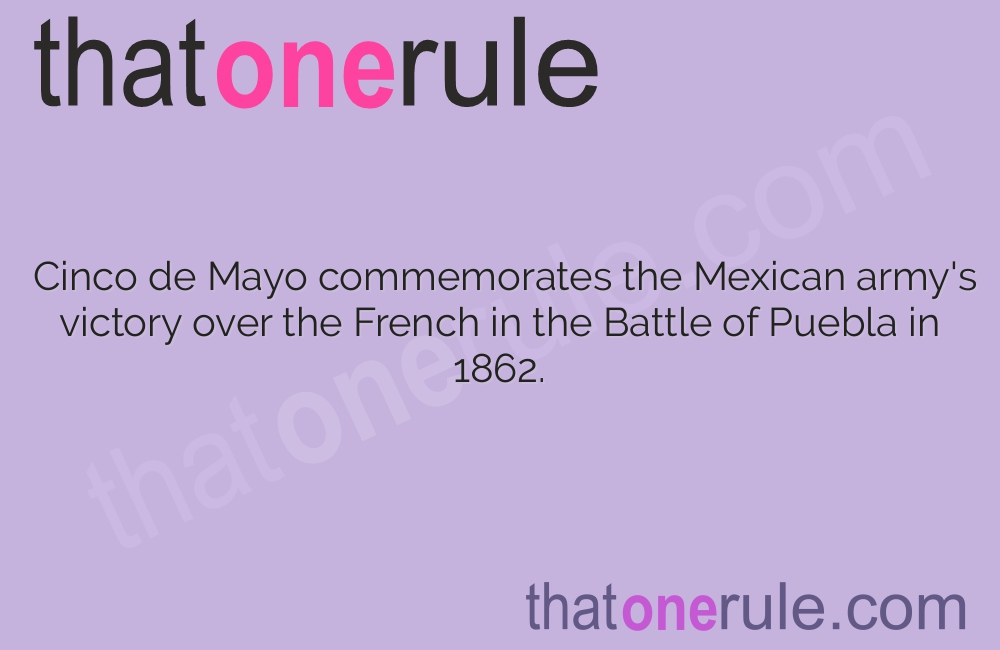Interesting Facts about Cinco de Mayo

Cinco de Mayo commemorates the Mexican army’s victory over the French in the Battle of Puebla in 1862.
Despite popular belief, Cinco de Mayo is not Mexico’s Independence Day, which actually falls on September 16th.
Cinco de Mayo is widely celebrated in the United States, especially in areas with large Mexican-American populations.
The largest Cinco de Mayo celebration takes place in Los Angeles, California, attracting thousands of participants each year.
In Puebla, Mexico, where the famous battle occurred, Cinco de Mayo is a major holiday with parades, reenactments, and fireworks.
Cinco de Mayo is not recognized as a national holiday in Mexico, but it is a regional holiday in Puebla.
Americans consume an average of 81 million avocados on Cinco de Mayo, making it one of the biggest avocado consumption days of the year.
The origins of the term Cinco de Mayo can be traced back to the Spanish language, where cinco means five and mayo means May.
Cinco de Mayo celebrations often include traditional Mexican foods like tacos, enchiladas, and guacamole.
Mariachi music is commonly heard during Cinco de Mayo celebrations, adding to the festive atmosphere.
Cinco de Mayo is a day to celebrate Mexican culture and heritage, promoting unity and pride.
McDonald’s once tried to trademark the phrase McMacho Nugget to promote a new Cinco de Mayo menu item.
Cinco de Mayo gained significant popularity in the United States during the Chicano movement of the 1960s and 1970s.
Interesting Facts about Cinco de Mayo part 2
The holiday has become a symbol of Mexican-American pride and serves as a reminder of historical victories against oppression.
In some parts of Mexico, Cinco de Mayo is celebrated with traditional dances like the Jarabe Tapatío (Mexican Hat Dance).
Colorado was the first state to make Cinco de Mayo an official state holiday in the United States.
Cinco de Mayo celebrations often feature parades with colorful floats and participants dressed in traditional Mexican attire.
The Battle of Puebla, which Cinco de Mayo commemorates, was fought against a well-equipped French army that outnumbered the Mexican forces.
Some cities in the United States hold Cinco de Mayo-themed festivals, featuring performances, art exhibits, and cultural activities.
Corona Extra, a popular Mexican beer brand, typically sees a significant increase in sales leading up to Cinco de Mayo.
Mexican-Americans have played a significant role in promoting and preserving Cinco de Mayo traditions in the United States.
The largest Cinco de Mayo celebration outside of Mexico takes place in Chandler, Arizona, attracting over 100,000 attendees.
In the city of Puebla, Cinco de Mayo is a day off from work or school, allowing residents to fully partake in the celebrations.
Cinco de Mayo is often associated with vibrant colors, as decorations and attire during the celebrations tend to be vibrant and festive.
The United States celebrates Cinco de Mayo on the 5th of May, while Mexico primarily recognizes it with activities only taking place in Puebla.
The Battle of Puebla lasted for only one day, but it stands as a symbol of Mexican resilience and determination.
Cinco de Mayo celebrations spread beyond Mexico and the United States, with countries like Canada, Australia, and New Zealand also joining in the festivities.
Traditional Mexican folk dances, such as La Bamba, are often performed during Cinco de Mayo events.
Cinco de Mayo has become a symbol of unity and cultural pride for Mexican-Americans, as well as an opportunity to educate others about Mexican history and culture.
The Battle of Puebla marked the first time in nearly 50 years that a European colonial power had been defeated in the Americas.
In some parts of Mexico, Cinco de Mayo is celebrated by recreating the Battle of Puebla through reenactments and military parades.
Many schools in the United States hold educational events and cultural fairs on Cinco de Mayo to teach students about Mexican history and traditions.
Cinco de Mayo celebrations often include traditional Mexican games, such as piñata smashing and Mexican bingo, known as lotería.
The Battle of Puebla is not to be confused with the Mexican War of Independence, which spanned from 1810 to 18
Cinco de Mayo celebrations have evolved over time, incorporating both traditional and modern elements to accommodate diverse audiences.
Some Mexican-American communities organize beauty pageants or folk dance competitions as part of their Cinco de Mayo festivities.
In Tucson, Arizona, the annual Cinco de Mayo Chihuahua races attract hundreds of small dog owners who race their Chihuahuas for fun and prizes.
The Battle of Puebla disrupted France’s plan to establish a French-controlled empire in Mexico and altered the course of history.
Cinco de Mayo celebrations highlight the cultural significance of Mexican cuisine, which has gained immense popularity worldwide.
The holiday’s growing popularity in the United States has led to the creation of various Cinco de Mayo-themed events, including salsa competitions and tequila tastings.
According to a study conducted by the National Restaurant Association, Cinco de Mayo is the busiest day of the year for Mexican restaurants in the United States.
Cinco de Mayo has become an occasion for people of all backgrounds to come together and celebrate diversity and cultural exchange.
The Cinco de Mayo celebratory atmosphere extends beyond Mexican restaurants and homes, with many bars and clubs hosting themed parties and drink specials.
Cinco de Mayo has been recognized and celebrated by various political leaders and organizations as a day of cultural appreciation and unity.
Despite being a relatively small-scale battle in terms of military significance, the Battle of Puebla has left a lasting impact on Mexican and Mexican-American history, making Cinco de Mayo an important occasion to remember and honor.

